Bernarda’s Daughters
Inspired by Federico Garcia Lorca’s "The House of Bernarda Alba," Diane Exavier’s new Haitian version actually uses very little from the Spanish tragedy.
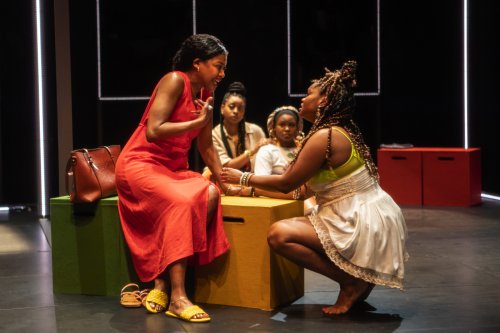
Pascale Armand, Alana Raquel Bowers, Kristin Dodson and Malika Samuel in a scene from The New Group and National Black Theatre’s production of Diane Exavier’s “Bernarda’s Daughters” at The Pershing Square Signature Center (Photo credit: Monique Carboni)
[avatar user=”Victor Gluck” size=”96″ align=”left”] Victor Gluck, Editor-in-Chief[/avatar]
Inspired by Federico Garcia Lorca’s The House of Bernarda Alba, Diane Exavier’s Bernarda’s Daughters actually uses very little from the Spanish tragedy. Both plays deal with five sisters under the thumb of their domineering mother Bernarda (the leading character) after the death of their father in an all-female cast. However, while Lorca’s play starts with the funeral, here Bernarda is in Haiti arranging for the burial and never appears on stage.
Reset in contemporary Flatbush, Brooklyn, in Exavier’s new play, the Abellard sisters are not the prisoners of their class and breeding as in Lorca, but have jobs or college to keep them occupied as well as boyfriends. Dominique Rider, directing this co-production between The New Group and the National Black Theatre, has made some strange design choices which affect the understanding of the play.
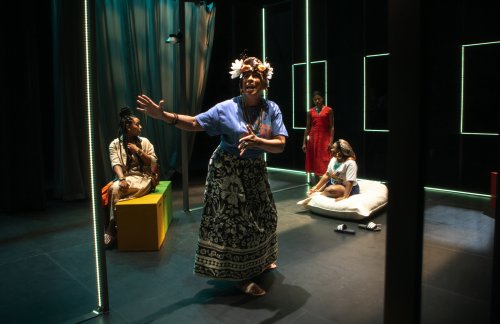
Alana Raquel Bowers, Tamara Tunie, Pascale Armand and Kristin Dodson in a scene from The New Group and National Black Theatre’s production of Diane Exavier’s “Bernarda’s Daughters” at The Pershing Square Signature Center (Photo credit: Monique Carboni)
While Lorca’s play has a through line about the oldest sister about to get married to Pepe el Romano who is desired by all of the other sisters and the only man in their lives, Bernarda’s Daughters has no obvious plot except the revelation of information that the sisters discover about the disposition of their father’s property, Brooklyn house, money, and land in Haiti. In the new play, the sisters spend their time discussing the gentrification of their neighborhood by racist white residents, the noisy construction next door, a protest march over a Black man who has been shot by the police, family memories, the terrible heat of the New York summer and boys who they do not seem to love. The walls seem to be closing in on them due to the new white neighbors and the construction fence which has been put up on their very lawn.
In the new play, Louise, the oldest sister, is still the daughter of their father’s first marriage and the most authoritative of the five. A nurse nearly engaged to the rich Matt, a white man, she is considering breaking off the relationship. Sister Harriet is a librarian who has recently ended a relationship with Richard whom she did not find satisfying. We learn the least about Maryse, the middle sister who seems to be more man-crazy than her sisters. The independent Adela has moved out and has an apartment and a job of her own.
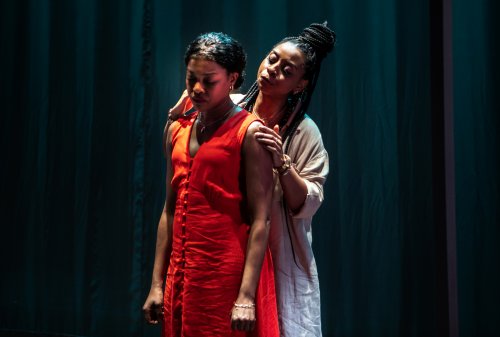
Pascale Armand and Alana Raquel Bowers in a scene from The New Group and National Black Theatre’s production of Diane Exavier’s “Bernarda’s Daughters” at The Pershing Square Signature Center (Photo credit: Monique Carboni)
Youngest sister Lena (short for Magdalena as in Lorca) is attending college and is addicted to reality programs on television. Like in The House of Bernarda Alba, the grandmother here called Florence Delva seems to be senile and the family has to try to keep her inside the house rather than roaming the neighborhood. However, while Lorca’s Maria Josefa has retreated to her youth and wants to marry again, Florence Delva wants to lavish affection on a stray cat she has rescued.
As directed by Rider, it is at times difficult to keep the sisters differentiated other than Pascale Armand’s Louise (dressed in a red orange shift) and Kristin Dodson’s Lena who is mainly seated before the invisible television set. The sisters come and go without any direction other than Louise’s trips to the lawyer to hear about the father’s will. Tamara Tunie’s appearances as the grandmother are nearly comic relief but do not add much to the play except for her memories of life long ago in Haiti.
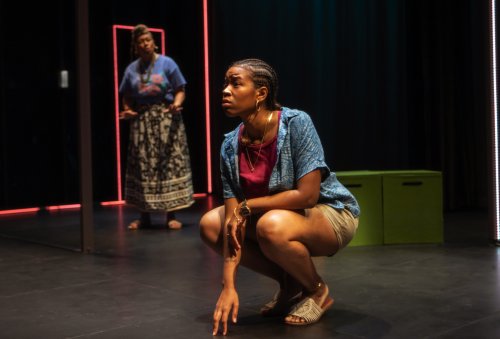
Taji Senior with Tamara Tunie (at left) in a scene from The New Group and National Black Theatre’s production of Diane Exavier’s “Bernarda’s Daughters” at The Pershing Square Signature Center (Photo credit: Monique Carboni)
Carlos J. Soto’s set is problematic. The scene is describe by one of the sisters (Maryse) at the beginning of the play as “The decor ranges anywhere from late seventies to early aughts. .. Things have been sort of piled onto each other. …Someone – our mother – spent too much money on all this at some point and still has too much pride in it.” However, Soto has taken his cue from Louise’s description instead: “If you were to say… put on a play about us, there would be no center-staged couch, no staircase, no fabrication of a gentrifying a city just outside the windows.”
The set which is a diaphanous box with lit poles representing doors and windows in changing colors and black archways uses curtains that are periodically pulled back to make the space bigger. Unfortunately, the poles make it difficult to see and the lack of furniture other than pillows on the floor, duffel bags of laundry, and yellow, green and red storage boxes create no atmosphere of any kind. Stripped down this way, the set does not allow us to concentrate more, but is distracting and often in the way of viewing the five acts performed without an intermission.
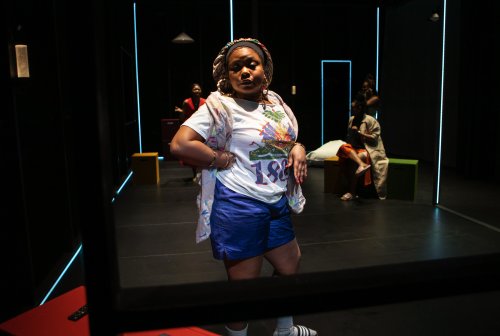
Kristin Dodson and the cast of The New Group and National Black Theatre’s production of Diane Exavier’s “Bernarda’s Daughters” at The Pershing Square Signature Center (Photo credit: Monique Carboni)
The six-member cast creates a believable ensemble though their roles are not all clearly defined. While the play reveals much about the Haitian community living in Brooklyn, as Bernarda’s Daughters feels almost plotless it seems to drift from one conversation to another with little or no structure. The idea of an updated Americanized version of Lorca’s very Spanish tragedy The House of Bernarda Alba is a good one. However, this is not as compelling or successful as Marcus Gardley’s The House That Will Not Stand which reset the play in 1813 New Orleans.
Bernarda’s Daughters (through June 4, 2023)
The New Group and National Black Theatre
Romulus Linney Courtyard Theatre at The Pershing Square Signature Center, 480 W. 42nd Street, in Manhattan
For tickets, call 917-935-4242 or visit http://www.tickets@thenewgroup.org
Running time: one hour and 45 minutes without an intermission






Leave a comment